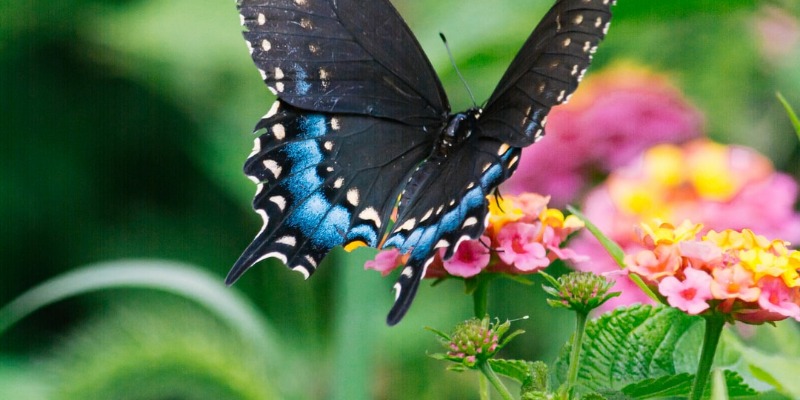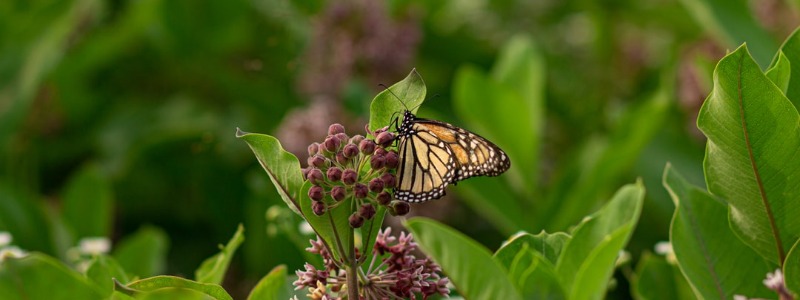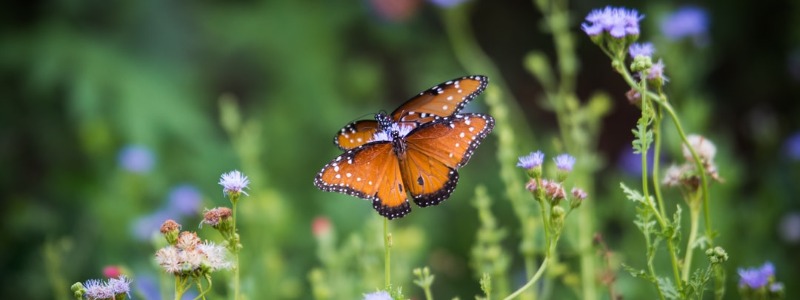How to Create a Butterfly Garden
Did you know that only about 10% of monarch butterfly eggs hatch into butterflies? When butterflies place their eggs on milkweed leaves, other bugs eat the eggs or the tiny caterpillars that hatch.
Many butterfly feeding and breeding grounds have been destroyed because of pesticides and the construction of housing and shopping centers. So creating a butterfly garden will not only attract these beautiful winged creatures to your yard, but can help them flourish again.
Butterflies are easy to attract
You just have to know what they like to eat. Caterpillars eat “larval” plants like milkweed, marigolds, Queen Anne’s lace, and violets. Butterflies like “nectar” plants, like the butterfly bush, the beauty bush, sunflowers, lilacs, snapdragons, and zinnias.
Select plants that are diverse in color and bloom at different times, so you will attract butterflies all summer long. Check with a nursery to see what plants will grow well in your area, and understand that different plants attract different butterflies and caterpillars.

Be sure the area receives five to six hours of sun a day and is sheltered from the wind. Also, a mud puddle in a sunny spot will provide butterflies with other essential salts and nutrients.
Watching these flying flowers flit around your garden is delightful. And the satisfaction of preserving a species by providing a safe habitat is immeasurable.
Butterfly Food Requirements
Rather than the chewing mouthparts of immature caterpillars, adult butterflies have sucking mouthparts. The mouthparts are shaped into a long coiled tube, called a proboscis. The adult butterfly can uncoil its proboscis and use it to suck up nectar or tree sap. Plants that adult butterflies use for food are called nectar plants.
Caterpillars or larvae use their chewing mouthparts to eat the leaves and stems of plants, called host plants. Some larvae, like the gypsy moth that feed in great numbers, can completely defoliaste a mature host plant in a matter of days.
Many butterflies have very specific food requirements. Often the host plant for the caterpillar isn’t the same nectar plant for the adult butterfly of the same species. To be a successful butterfly gardener you must provide both the host and nectar plants that the butterfly species in your area prefer to eat.
Monarch Butterflies
Monarch butterfly populations have declined over the years as their crucial overwintering habitat in Mexico and California has been attacked by loss of milkweed breeding habitat, pesticide use, and logging at winter sites. According to scientists, numbers in the East have decreased by approximately 80%, while numbers in the West have decreased by approximately 99.4%. This is why it is critical for citizens to help conserve milkweed by growing it. Monarch caterpillars rely entirely on milkweed plants.

The lists below give some examples of common host plants for caterpillars and nectar plants for butterflies throughout the United States. Ask your local nursery staff which ones are best suited for your area and climate.
Common Host Plants for Caterpillars
The plants that caterpillars eat are known as host plants, whereas the plants that adult butterflies consume (actually, they “drink” nectar from the flowers) are known as nectar plants. Each butterfly species has a unique host plant upon which adult butterflies place their eggs.
- Alder
- Carrot
- Grasses
- Parsley
- Spicebush
- Anise
- Ceanothus
- Hackberry
- Passion vine
- Sunflower
- Aspen
- Cherry
- Hollyhock
- Plantain
- Verbena
- Aster
- Citrus
- Hops
- Plum
- Violet
- Apple
- Clover
- Lilac
- Pipevine
- Wild sienna
- Baby’s tears
- Coast live oak
- Mallow
- Poplar
- Willow
- Buckthorns
- Cottonwood
- Milkweed
- Sassafras
- Cabbage
- False indigo
- Nasturtium
- Sedges
- Canyon live oak
- Fennel
- Nettle
- Snapdragon
Common Nectar Plants for Butterflies
Choose native plants for your Dripping Springs garden if possible because they are the most hardy and are found naturally for the butterfly species that live in your area. Alternatively, your local nursery can assist you in determining which plants are native to your area.
You should be aware of two types of plants. Plants that provide nectar to butterflies and plants that provide food to caterpillars exist. The best butterfly gardens provide both of these so that butterflies will show up to your garden to feed, lay eggs, and reproduce.
There are numerous plant species that provide nectar to butterflies. Many garden centers also included this information on plant tags, so look for words like “butterfly friendly” or something similar. However, don’t hope these to be caterpillar-friendly. Plants that local caterpillars will eat must be present in your garden for butterflies to lay eggs.
- Anise
- Cassia
- Heliotrope
- Mint
- Sunflower
- Aster
- Chrysanthemum
- Hibiscus
- Mustard
- Sweet pepperbush
- Bee balm
- Clover
- Hollyhock
- Nasturtium
- Sweet William
- Black-eyed susan
- Coreopsis
- Honeysuckle
- Oregano
- Thistle
- Blazing stars
- Cosmos
- Impatiens
- Parsley
- Verbena
- Buckwheat
- Daisy
- Joe-pye weed
- Passion vine
- Violet
- Buddleia
- Daylily
- Lantana
- Peppergrass
- Yarrow
- (or butterfly bush)
- Dogbane
- Lavender
- Phlox
- Zinnia
- Butterfly weed
- Echium
- Lilac
- Purple coneflower
- Cardinal-flower
- Firebush
- Marigold
- Queen Anne’s lace
- Carrot
- Fleabane
- Mexican flame vine
- Sumac

